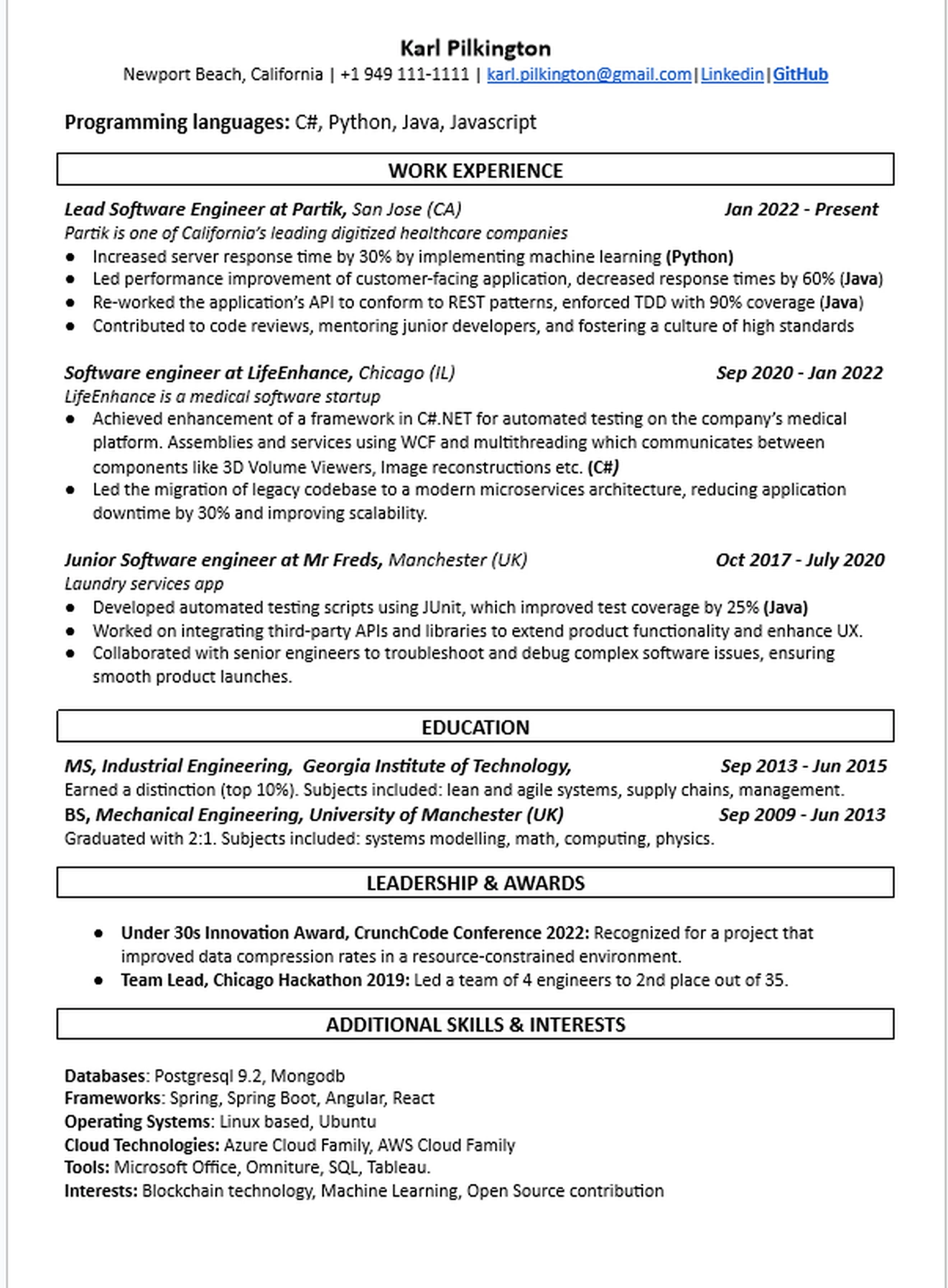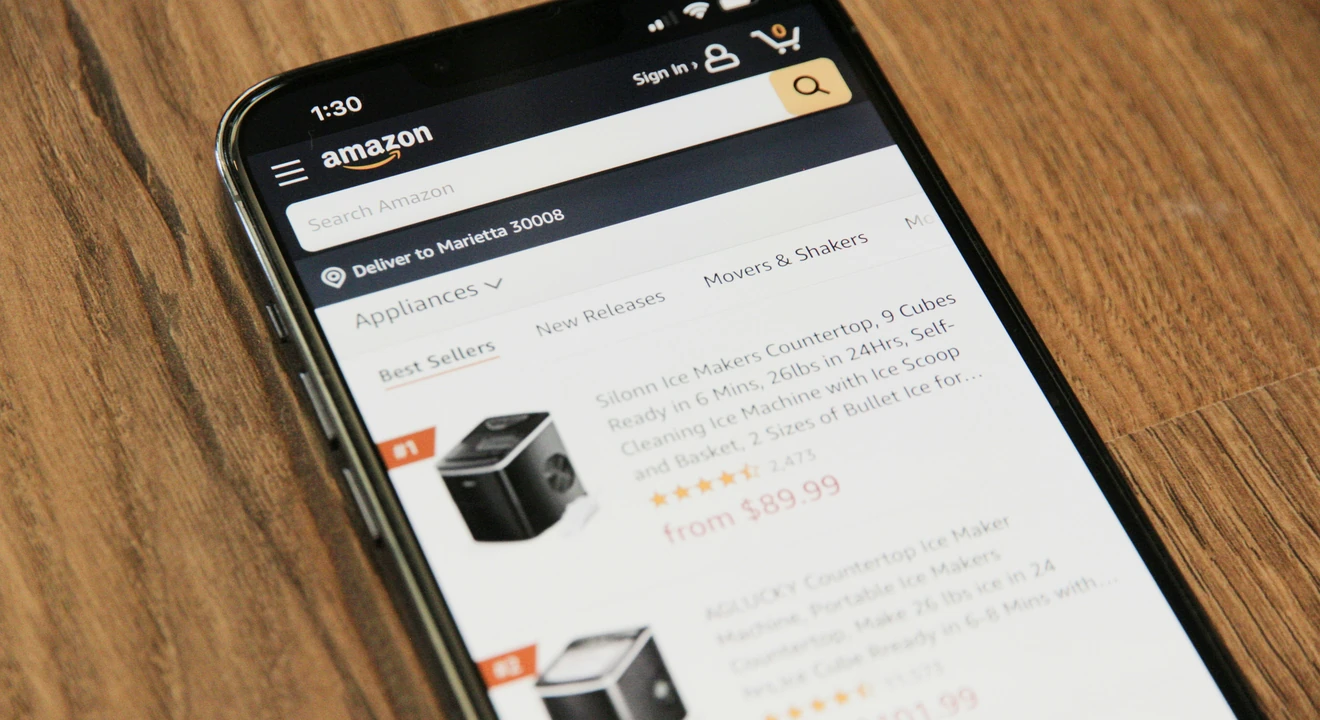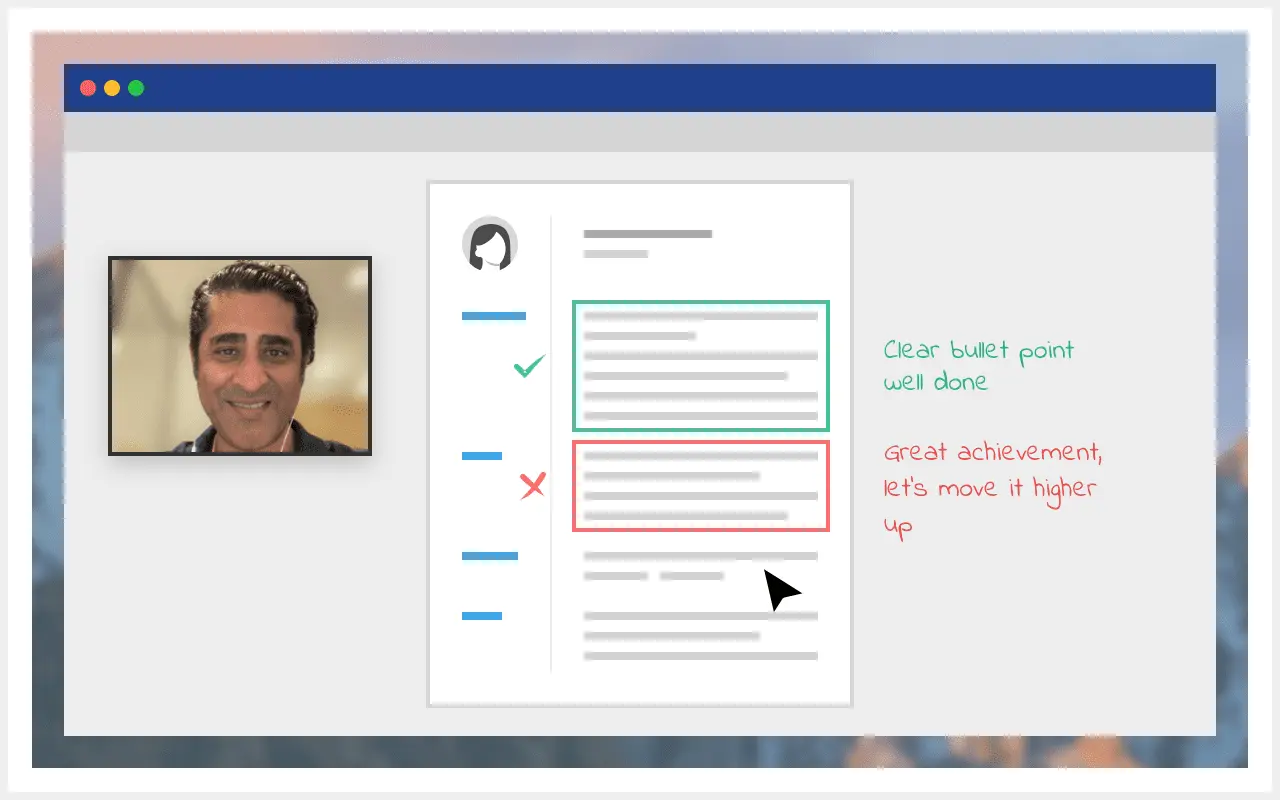Amazon is one of the top tech companies in the world, so it goes without saying, it’s tough to get into.
But before you can even think about how to crack their challenging interview process, you’ll need to get your resume noticed.
To help you increase your chances of clearing the resume screening, we’ve prepared a sƒtep-by-step guide to writing an outstanding Amazon resume/CV.
It includes tips and expert insights as well as REAL examples of resumes that earned candidates offers or interviews at Amazon. We also provide a template that you can use as a guide to get started.
Here’s an overview of what we’ll cover:
- 6 Amazon resume tips
- 8 real resume examples that worked for Amazon
- Amazon resume template
- How to write a resume for Amazon (section-by-section)
- Your Amazon resume checklist
Let’s get started.
Click here to get expert feedback on your resume from an ex-Amazon recruiter or interviewer
1. 6 Amazon resume tips↑
As you'd expect, Amazon recruiters have the highest standards. They also have certain things that they are particularly keen on, so, no matter what role you're applying for, follow these six crucial tips:
1.1 Use the X, Y, Z formula
The "Accomplished [X] as measured by [Y] by doing [Z]" formula is great for structuring your bullet points and really showing quantifiable results and impact on your resume.
The format was made famous by ex-Google VP Lazlo Bock, but it’s not just for Google. It’s an excellent format to use on your resume, no matter where you’re applying.
Examples:
"Achieved a 40% reduction in critical bug resolution time by leading a cross-functional team and implementing immediate code fixes."
"Achieved a 25% increase in user NPS scores by initiating a customer-centric approach based on extensive user research and feedback analysis."
1.2 Demonstrate leadership skills
Unlike Meta and Google, Amazon follows a top-down decision-making process, giving the executive team a relatively high degree of control.
The company does give its function-based teams and regional groups some room to experiment and innovate to help the global company address the rapidly changing needs of customers.
As ex-Amazon interviewer Dessy explained to us, teams at Amazon operate relatively independently, almost like their own start-ups. It grants lots of autonomy to its engineers and product managers, so it doesn't want to hire people who are only good at executing tasks and following established processes.
Regardless of whether you're applying for a leadership role or not, Amazon wants to see that you have what it takes to be a leader.
So include examples where you led a project, took the initiative, or influenced other people. You may want to include a "Leadership and Awards" section in your resume.
Examples:
"Reduced system downtime by 60% by spearheading the migration to a microservices architecture, coordinating efforts across engineering, product, and QA teams."
"Hired a team of product managers and engineers across China, India, and Europe."
If you haven’t got many strong examples from your work experience, try to find examples from personal projects or university (if recently graduated).
1.3 Show alignment with Amazon’s Leadership Principles
Whether you’re applying for a leadership role or not, Amazon wants to see if you adhere to their Leadership Principles (LPs).
If you’re not familiar with the Leadership Principles, here’s a quick look:

Amazon's Leadership Principles encapsulate the core values and behaviors that guide decision-making and actions across the company.
Each principle emphasizes different aspects of Amazon's culture, from prioritizing customer needs to fostering innovation, maintaining high standards, and acting with urgency and integrity.
Take a look at our complete guide to Amazon’s Leadership Principles to learn more.
You don’t necessarily have to take into account every principle when crafting your resume bullet points; you can simply use them as a guide when framing your impact.
Examples:
Demonstrating Frugality
"Saved $1M in operational cost by delivering investigator tooling workflow automations"
Demonstrating Ownership
"Defined 4 KPIs to achieve by executing a testing roadmap for store launch onsite and email campaigns"
1.4 Highlight your most relevant skills
It goes without saying that if you're an engineer, you'll automatically be including lots of technical skills on your resume. Be sure to label them properly.
Example:
Programming languages: Java, Python, JavaScript
Databases: Postgresql 9.2, Mongodb
Frameworks: Spring, Spring Boot, Angular, React
If you don’t have space in your resume, Amazon suggests weaving your technical skills into your bullet points.
Example:
"Designed and led an effort (for 4) for a frictionless Single Sign-on authentication experience on the platform with multiple partner teams. (Tech stack: OAuth, AWS, systemd, aosp.)"
1.5 Emphasize your customer-centric approach
Customer Obsession is Amazon’s top Leadership Principle, so it might be good to emphasize this in your resume.
You don’t necessarily have to have customer-facing experience. If you’ve worked on initiatives or projects aimed at improving customer experience, that’s worth highlighting. Be sure to include success metrics to emphasize impact.
Examples:
"Decreased customer response times by 70% by working on performance improvement of the customer-facing application."
"Achieved a 25% increase in user NPS scores by initiating a customer-centric approach based on extensive user research and feedback analysis."
1.6 Don’t forget about your communication skills
Good communication skills are important if you want a top role at Amazon, and if you get to the interview stage, you will be tested on them.
But don’t wait until then. Try to include experience that highlights your communication skills on your resume. One great example is cross-functional collaboration experience.
Outside work achievements, skills, or interests (such as foreign languages, volunteer work) can be a great way to show that you're a solid communicator.
If you're applying for a management role, communication skills become even more important. One way to demonstrate that is by listing experiences dealing with different stakeholders, clients, and partners.
Examples:
"Presented findings and recommendations to client on a regular basis to obtain stakeholder buy-in."
"Facilitated alignment meetings with non-technical stakeholders during product reviews, accelerating feature approvals by 30%."
2. 8 real resume examples that worked for Amazon↑
Before we start guiding you on how to write your resume step-by-step, take a look at some real examples that got their owners interviews at Amazon. Most of them are now or have been Amazon employees.
You'll notice they follow different formats, and none fully follow the guidelines we set out below. We think this shows two things:
- There are many acceptable ways to write a resume
- Your resume doesn't have to be perfect, as long as it demonstrates your skills and achievements effectively.
Note that we’ve anonymized the following resumes and used pseudonyms to protect our sources’ privacy.
Let's take a look.
2.1 Amazon resume example 1 (product manager)
This resume got “Jennifer” an L5 product manager role at Amazon.

Here's what we think makes this resume attractive:
- Concise and well-structured: Jennifer doesn't have many years of experience, so she starts with her Education section, which is fine, and keeps it to one page.
- Metrics: Jennifer gives specific details about her achievements, e.g., hours saved, size of the budget approved. This helps the recruiter understand her impact.
2.2 Amazon resume example 2 (software development engineer)
“Sanju” is currently a software development engineer who’s made a successful internal move at Amazon. Here’s his current resume:


Here’s what makes Sanju’s resume work:
- Structure: His resume has a clear and easy-to-read structure.
- Quantified impact: His roles and even his extracurricular achievements include numbers that indicate his success.
- Academic achievements: He makes sure to include his projects, publications, and certifications. They show that he’s always keen to learn and broaden his knowledge and expertise.
2.3 Amazon resume example 3 (senior software development engineer)
The candidate, let's call him "Sunil", got interviews for a Senior Software Development Engineer (SDE) role at Amazon with this resume.


Here's our feedback on this resume:
- Experience: We had to blank them out, but Sunil had worked for some really top tech companies. This is what makes the resume really strong.
- Quantifying impact: Sunil could perhaps enhance his resume by better quantifying his actions and demonstrating their impact. For example, he says he "Revised Telemetry dashboards to improve signal-noise ratio". How much did he improve it? Including specific metrics more often would take this resume to the next level.
- Key skills: Sunil lists key skills and tools that were likely listed as requirements in the job description. This makes a recruiter's life easier.
2.4 Amazon resume example 4 (senior machine learning engineer)
“Vikash” is currently an adjunct lecturer and a senior machine learning software engineer at Amazon Ads, and here’s his current resume.


- Simple and concise: It’s a one-pager that contains Vikash’s years of relevant experience, educational attainment, and technical skills. It would be easier to read if the bullet points had a more consistent format.
2.5 Amazon resume example 5 (software development manager)
This is the resume that got “Sarah” a software development manager role at Amazon. She also got calls from Meta and Google with the same resume.


We think what made Sarah’s resume stand out is that it was highly focused on leadership.
- Diversity of leadership experience: She makes sure to highlight the roles in which she acted as a leader in an official capacity. She includes the methodologies that she used, her domain expertise, and her breadth of experience in various industries.
- Extracurricular leadership: She also includes ventures outside her role, which further highlighted her leadership, including her various certifications and the extracurricular initiatives she led.
2.6 Amazon resume example 6 (software development manager)
Below is another resume that earned its owner "K" interviews for an SDM role at Amazon.




Here's our feedback on this resume:
- Adapted for target company: K knew that her experience with AWS Cloud engineering would be important to Amazon, and so she put it right at the top.
- Tools and technologies: K demonstrates experience with a vast number of engineering technologies.
- Length: This is a 4-pager! She got the interview anyway, but K would have helped recruiters by cutting it to two pages.
2.7 Amazon resume example 7 (software development manager)
The resume below is from “Amar”. It's not the resume that got him into Amazon, rather it's his current resume.




Here’s what Amar does well in his resume:
- Quantified impact: He gives specific numbers and metrics to clearly state the impact of his achievements.
- Clarity: Most of the bullet points are 1 line, maximum 2. There is plenty of white space, and it's extremely easy to read and understand.
- Open-source contributions: It's great to include these on a resume as it shows passion for engineering and suggests a collaborative mindset.
2.8 Amazon resume example 8 (software development manager)
The resume below is another current resume from an Amazon software development manager.

Here are some of the best practices you can lift from this resume:
- Concise and well-structured: The resume is able to include all the most important information in a 10-year career.
- Focused on impact: Only the most recent positions are highly detailed. The other older roles are given a bullet point each, highlighting the candidate’s biggest achievement in each role.
3. Amazon resume template↑
Now you've seen some examples, let’s look at a resume template applying our recommendations.
Unlike the examples listed above, this is not a real resume. It belongs to an imaginary mid-level software engineer called Karl. It's an amalgamation of the many high-quality resumes that candidates have shared with us before going on to work at Amazon and other FAANG+ companies.
Even if you're not an engineer, you can still follow this same template, just remove the 'Programming languages' from the top of your resume.

Click here to download this Amazon resume template as a PDF.
Click here to open this Amazon resume template as a Google Doc.
4. How to write a resume for Amazon↑
Now that you’ve seen examples of what you should be aiming for, as well as some key tips, let’s go through the resume-building process, step-by-step.
4.1 Do your research
Got a specific role you’re targeting? Read the job description thoroughly, and use it to shape your resume in the following ways:
- First of all, work out what type of profile Amazon is looking for. Which skills will be most crucial for the role? Prepare to adapt your resume’s content accordingly.
- Zoom in on a few of the responsibilities in the job description that you think are most important. Search for specific examples from your past that demonstrate experience in doing the same thing or something very similar. Find the numbers to back it up where possible, so you’re ready to include this information in the work experience section later on.
- Take note of the language used in the job description so you can, where appropriate, match specific verbs and phrases.
You also need to research more about the company. Amazon is such a ubiquitous part of our lives that you might think you already know enough about it. But to create a great Amazon resume, you need a better understanding of the company than the average applicant.
Take a look at Amazon’s culture, and think about which of your experiences or achievements might be relevant to the topics articulated there.
You might also want to read up on the latest articles in their newsroom to learn more about the developments at the company.
4.2 Choose a layout
The design of your resume should have one objective: to convey as much information as possible in a way that is clear, easy to digest, and professional. Use our resume template as your guide, and you’ve already achieved that!
Some people add a second objective: to demonstrate strong design skills to stand out from the crowd and impress the recruiter.
However, some recruiters might even be put off by a “creative” or unique design, and in a worst-case scenario, it could prevent your resume from being properly processed by the ATS.
Keep it clean and simple. Avoid including your photo in your resume, as this goes against employment and discrimination laws in most countries, and is another potential problem for ATS.
How long should your Amazon resume be?
Many candidates ask us if they should stick to just one page. If you’ll notice, the real Amazon resumes we’ve provided here vary in length. Some have a single page, while others have two.
So, the answer is not necessarily, but it helps you stand out.
If you have 10 years of experience, you might warrant a 2-page resume. A good rule of thumb is “1 page for every 5 years of experience”.
If you feel like two pages are not enough to showcase your professional achievements, take advantage of your LinkedIn profile. Be sure to link to your actual profile on top of your resume so your recruiter can easily click on it and check it out.
4.3 Choose your sections
There are lots of ways to write a resume, and the exact sections you include are up to you.
We recommend using the following sections for a tech resume because we know this approach works for Amazon and other FAANG+ companies, for both junior and experienced candidates.
- Personal information
- Work experience
- Education
- Leadership and awards
- Skills and interests
Whether or not you stick exactly to these suggested categories, we highly recommend keeping these general layout/design tips in mind:
DO:
- Choose a professional-looking font: Size 10-12, black and white. Arial and Calibri work well.
- Save it as a PDF or DOCX
- Use bullet points
- Make sure the formatting is 100% neat and consistent
- Include enough white space so that it doesn’t look overcrowded
DON’T:
- Include references
- Pick an unusual font to try and stand out
4.4 Start writing
The good news is, you don’t have to get it perfect the first time. A strong resume is usually one that is rewritten and tweaked multiple times.
We’ve spoken to tech recruiters to get guidance on how to write up each section. Let’s take a look.
4.4.1 Personal information section
This section is not the place to try and impress. Just make sure you get your details across in as few words as possible and avoid mistakes.
If you're an SDE or similar, you should include your programming languages here at the top of your resume.
Here are some more tips:
DO:
- Use a bigger font for your name than for the rest of the section to make it stand out
- Include your name, email address, phone number, city/county you live in/work location preference (remote, onsite, hybrid)
- Ideally, include a link to your LinkedIn profile (or GitHub if you have an engineering background)
DON’T:
- Title this section. It’s not necessary in this type of layout, so save the space.
- Include a street address; it’s unnecessary and unsafe
- Include a photo, date of birth, or gender, unless specifically requested to do so
- Label each piece of information, e.g., “email:”, “tel:”, etc. It’s obvious what they are, so save the space.
4.4.2 Work experience section
This is probably the most important part of your resume to get right, and the easiest to get wrong. Many candidates think that their work experience speaks for itself, and simply list their role and a few of their main responsibilities.
However, we recommend a much more powerful approach.
Instead of listing responsibilities, you need to talk about actions. This means starting each bullet point with an action verb. "Executed," "Negotiated," "Led," and "Delivered" are some good examples of such verbs.
Choosing actions that are relevant to the essential tech skills will also mean that your resume contains the keywords that recruiters and ATS will be looking for.
You can use the “X, Y, Z” formula we mentioned in Section 1, but don’t feel you have to follow it to a T. It’s just a good guide for writing clear, specific, and quantifiable examples of your impact.
Finally, balance can be very important if you’re applying for a multi-faceted role, like product manager, software development manager, or technical program manager. If so, try and demonstrate a range of skills in the work experience section.
Ready to start writing this section? Use the tips below to keep you on the right track.
DO:
- Use reverse chronological order, putting the most recent employment at the top
- Use present-tense verbs (e.g., "Lead, Coordinate, Execute") in your current position (except for completed achievements), and past-tense verbs for past positions and completed achievements (e.g., "Led, Coordinated, Executed")
- If you're an engineer, consider including the programming language you used for each project
- Describe your actions and what they achieved
- Include metrics to quantify what your actions achieved, where possible
- Study the language of the job description and, where appropriate, match it
- Make sure you’ve naturally included several relevant keywords
- Demonstrate a balance of skills
DON’T:
- Be shy and humble. Now is not the time!
- Just put your responsibilities
- Be vague
- Go so overboard with numbers that it looks like a math problem. It still needs to be easy to read.
- Include lots of buzzwords or jargon just for the sake of it
4.4.3 Education section
This section should be extremely concise and clear. Hopefully, your educational achievements can do the talking for you, as all you can really do here is present the necessary information with the right level of detail.
Note that if you have recently graduated and only have internship experiences instead of relevant work experience, this section should follow the Personal Information section, and you may want to go into a bit more detail. Otherwise, you can include it after work experience.
Follow the tips below to make sure you get it just right.
DO:
- If you have multiple degrees (e.g., a BA and an MBA), you should write a subsection like the one above for each degree, starting with your highest level of education first (e.g., your MBA)
- For each degree, include the name of the degree, university, and dates in the headline. If you’re a recent graduate, you can also list any projects/courses you have taken that are relevant to the role.
- List your grades (e.g., GPA) as well as results of other standardized tests you have taken (e.g., SAT, GMAT, etc.) that demonstrate your intellect
- Detail any awards and scholarships you received at university level, and most importantly, how competitive they were (e.g., two awards for 1,000 students)
DON’T:
- Panic if you don't have a degree. You don’t have to have gone to college to get into a FAANG company. Instead, put your high school grades and any relevant educational qualifications you gained after school.
- Include high school experience if you've already graduated
- Include your thesis / dissertation unless you're a fairly recent graduate, in which case you should summarize the topic in a way that's VERY easy to understand
4.4.4 Awards and leadership section
For this section, you can use “Awards and leadership” or “Extracurricular activities” depending on the bullet points you’ll include.
The more experience you have, the easier it should be for you to find two or three strong bullet points that demonstrate leadership (outside your day-to-day work) or awards.
If you haven't won any awards or can't think of any strong leadership examples outside your day-to-day role, then consider leaving out this section entirely.
DO:
- Put awards in context, e.g., "1st out of 22 applicants"
- Consider leaving this section out if you're lacking content
DON'T:
- Use awards from school or university if you graduated more than ten years ago
- Include weaker achievements (e.g., "employee of the week") just to fill space
4.4.5 Skills and interests
Your Amazon resume needs to show that you're adept at using a wide range of tools, methodologies, and technologies. List them here to make it easy for a recruiter to quickly check that you meet their requirements.
If you're applying for a technical role like software development engineer, stick to skills that are directly relevant to the role.
Non-technical candidates, such as product managers, may like to include skills that are not directly relevant to the role but are signals of soft skills and add personality to the resume–e.g., foreign languages, pet projects, etc.
If you think you don’t have room for a separate skills section, you can highlight them in your professional experience bullet points.
DO:
- If you need to save vertical space, list skills in sentences rather than bullets
DON’T:
- Include generic, uninteresting things that everyone likes doing, like “watching Netflix” or “hanging out with friends,” as interests
- List basic skills that almost everyone has, such as "Google Docs" or "MS Word"
4.5 Proofread and get feedback
Don’t skip this step! Use a grammar checking tool and then proofread until it’s perfect. This is harder than it sounds because multiple reviews and tweaking after the initial proofread can easily create new hard-to-spot errors. The only solution is to proofread again after each tweak.
We recommend saving your resume as a PDF or DOCX unless the job description says otherwise. Check that it opens properly (with the correct formatting) on a Mac or PC.
Getting feedback is also important. Share it with a friend or partner, and they’ll be very likely to see mistakes that you haven’t noticed. Of course, if you can share it with an experienced Amazon recruiter / interviewer, that can give you a big advantage over other applicants.
DO:
- Proofread from top to bottom and then read it in reverse to check spelling
- If you’ve tweaked it, proofread again before sending
- Check that the file opens properly on Mac and PC
- Get feedback on it before sending
DON’T:
- Send it with typos. Your resume is your first impression, so make it count.
5. Amazon resume checklist↑
Almost ready to send your resume to Amazon? Use this checklist to make sure you’re following the best practices we’ve recommended above.
If you can answer “Yes” to every question, then you’re ready to hit "Apply" or upload it to Amazon's job portal.
General
- Does your resume present you as the type of candidate the job description is looking for?
Layout
- Is it just one page? If not, do you have the experience to merit 2 pages?
- Is the formatting 100% consistent and neat?
- Is there enough white space to breathe?
Personal information
- Have you checked that your contact details are correct?
- If you're an engineer, have you listed your programming languages?
Work experience
- Have you talked about your actions rather than your responsibilities?
- Have you quantified the impact of your actions?
- Have you demonstrated a range of relevant skills?
Awards and leadership
- If you graduated >10 years ago, are your examples post-university?
Skills and interests
- Have you listed all the relevant tools and methodologies you’re familiar with?
- Do your interests make you stand out from the crowd in some way?
Proofreading and feedback
- Have you proofread since you last edited it?
- Have you received any feedback on your resume and updated it?
- Have you saved it as a PDF or DOCX to make sure it displays correctly on all devices?
Did you say “Yes” to every question? Well done!
If you’ve used all the tips in this article, then your resume should be in good condition and give you a fighting chance of getting an Amazon interview (and hopefully an offer).
If you’d like to see more resume examples for a particular role you’re targeting, check out our role-specific resume guides below:
- Tech resume examples
- Software engineer resume examples
- Product manager resume examples
- Machine learning engineer resume examples
- Engineering manager resume examples
- Technical program manager resume examples
6. Is your resume good enough for Amazon?
When you're targeting Amazon, having a resume that's "fine" isn't enough. Getting your Amazon resume from "fine" to "outstanding" usually requires feedback from someone who really knows their stuff - an ex-Amazon recruiter or hiring manager.
We know it's hard to get access to those types of people. That's why we've created a resume review service that allows you to get immediate feedback on your resume from a top Meta recruiter/coach of your choosing. Take a look!















